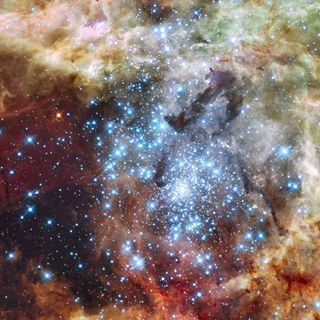Gazing upon the star-studded tapestry of the night sky, we can’t help but wonder about the origins of these celestial beacons. A recent discovery in the Large Magellanic Cloud (LMC), a satellite galaxy neighboring our Milky Way, has cast a new light on this cosmic quest.
Scientists have unearthed a relic from the universe’s infancy – a second-generation star named LMC-119. This ancient fossil offers a unique window into the conditions that existed shortly after the Big Bang, before our Sun even ignited.
Echoes of Stellar Ancestors: Deciphering the Chemical Fingerprint
The first stars, colossal beings born from the primordial fire of the Big Bang, have long since burned out. But their fiery legacy lives on in the chemical fingerprints of subsequent stellar generations. Unlike their short-lived progenitors, second-generation stars like LMC-119 formed from gas clouds enriched by the ashes of these pioneering giants. By studying the composition of such ancient stars, astronomers essentially analyze the “cosmic ash” left behind by the first stars. This allows them to reconstruct the story of element formation in the early universe, a period shrouded in mystery.
Sifting Through the Stellar Ashes: Age Dating Through Elemental Abundance
Stars act like cosmic crucibles, fusing lighter elements into heavier ones within their cores. The abundance of these elements within a star serves as a marker for its age. Younger stars, born from gas clouds brimming with the accumulated elements forged by countless stellar generations, boast higher levels of heavier elements. Conversely, ancient stars, like LMC-119, harbor a much lower abundance of these elements, reflecting the composition of the universe closer to its birth. By meticulously analyzing the elemental makeup of LMC-119, astronomers can estimate its age to be a staggering 13 billion years old, making it a near contemporary of the universe itself.
Unearthing a Galactic Discrepancy: LMC-119 Reveals Chemical Diversity
Prior discoveries of ancient stars have been confined to our Milky Way. LMC-119, however, marks the first time such a relic has been identified in a neighboring galaxy. This discovery offers an unprecedented opportunity to compare the early conditions within our Milky Way to those in the LMC. Intriguingly, LMC-119 exhibits a significantly lower carbon content compared to ancient stars in our galaxy. This hints at intriguing differences in how the early universe forged heavier elements in distinct regions. It suggests that the environments within our nascent Milky Way may have differed substantially from those in the LMC, raising new questions about the uniformity of the early universe.
A New Era of Stellar Archaeology: Unveiling the Universe’s Chemical Makeup
The discovery of LMC-119 marks a pivotal moment in our understanding of galactic evolution. It ushers in a new era of “stellar archaeology,” where astronomers can leverage ancient stars in neighboring galaxies to reconstruct the chemical makeup of the early universe across vast cosmic expanses. This endeavor, spearheaded by astronomer Anirudh Chiti, involves meticulously sifting through data from telescopes like Gaia and the Blanco telescope, with the aim of unearthing a multitude of these celestial fossils – both within our Milky Way and beyond.

The image was provided by NASA, ESA, and Elena Sabbi (ESA, STScI).
By deciphering the stories encoded within these ancient stars, we gain a deeper appreciation for the intricate dance of elements that gave rise to our universe. We discover not only how the first stars transformed the primordial hydrogen and helium into the building blocks of life, but also how these processes may have varied across the nascent cosmos.
The quest to understand our cosmic origins continues, and with each discovery of a galactic fossil like LMC-119, we inch closer to painting a more complete picture of the universe’s grand narrative. LMC-119 serves as a powerful reminder that the cosmos is a place of rich diversity, even in its earliest epochs, and its story is far from fully told. The universe holds many more secrets waiting to be unveiled, and future generations of astronomers will undoubtedly continue to unravel the mysteries encoded within these celestial time capsules.



















